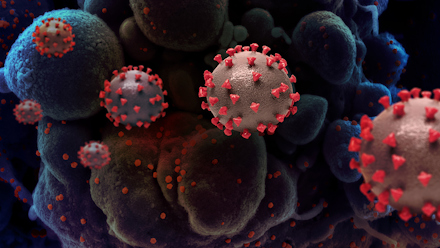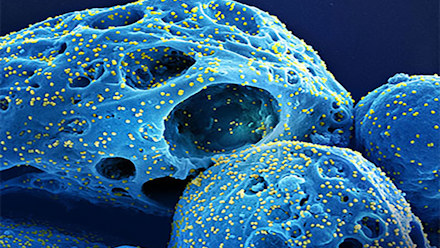Remdesivir is an antiviral drug originally discovered as part of a program to develop antiviral agents with activity against novel emerging viruses. In the first months of the COVID-19 pandemic, it was tested as a potential therapeutic and found to measurably reduce recovery time for hospitalized COVID-19 patients. The Food and Drug Administration approved its use in October 2020 and it remains the only FDA-approved antiviral for treatment of SARS-CoV-2 infection.
Currently, remdesivir must be administered intravenously, a process that restricts its use to patients hospitalized with relatively severe or advanced cases of COVID-19. The FDA has approved the use of remdesivir only for adults and children age 12 and older.
In a new paper, published in the July 26, 2021 online issue of Antimicrobial Agents and Chemotherapy, researchers at University of California San Diego School of Medicine describe cell and animal studies that demonstrate how lipid modifications of remdesivir nucleoside can improve drug delivery, effectiveness and toxicity compared to remdesivir.
“Although vaccine development has had a major impact on the epidemic, COVID-19 has continued to spread and cause disease — especially among the unvaccinated,” said co-first author Robert T. Schooley, MD, professor of medicine at UC San Diego School of Medicine. “With the evolution of more transmissible viral variants, breakthrough cases of COVID are being seen, some of which can be severe in those with underlying conditions. The need for effective, well-tolerated antiviral drugs that can be given to patents at high risk for severe disease at early stages of the illness remains high.”
Senior author Karl Hostetler, MD, professor of medicine at UC San Diego School of Medicine, and colleagues synthesized three new lipid prodrugs, which combine a therapeutic agent (in this case, remdesivir nucleoside) with one of several types of lipid-phosphates. The resulting conjugated molecule uses new pathways to enter cells: the lipid phosphate portion carrying along the drug.
The lipid phosphate prodrugs of the remdesivir nucleoside can be taken orally, remaining intact and bioactive in the body following absorption from the digestive system.
“COVID-19 is a two-stage disease,” said Schooley. “Rapid viral growth occurs shortly after infection and can trigger a misdirected immune response that results in an ‘inflammatory’ pneumonia in those who don’t do well. In order to be maximally effective, antiviral therapy must be given early in the illness before the inflammatory phase of the illness results in hospitalization. These compounds are designed to be taken orally, rapidly absorbed from the gastrointestinal tract and to largely bypass the liver where most of remdesivir’s toxicity is seen.”
To become active, remdesivir requires modification by multiple enzymes. This complicated metabolism likely contributes to variable antiviral activity and toxicity in different cell types. For example, remdesivir works well in lung cells, but is less effective in other organs and is relatively more toxic in hepatocytes (liver cells), which limits the amount of drug that can be administered to patients. In comparison, the lipid prodrugs described in the new paper are activated by a simple single enzymatic reaction and show a consistently potent antiviral activity and minimal toxicity across many cell types.
“An optimal antiviral for the treatment of SARS-CoV-2, and potentially other emerging viral infections, would be equally effective in any cell type that could be infected,” said co-first author Aaron F. Carlin, MD, assistant professor of medicine and an infectious disease specialist at UC San Diego Health. “The metabolism of remdesivir is complex, which may lead to variable antiviral activity in different cell types. In contrast, these lipid-modified compounds are designed to be activated in a simple uniform manner leading to consistent antiviral activity across many cell types.”
The researchers assessed the lipid prodrugs in a variety of animal and human cell types and found that the lipid prodrugs uniformly inhibited SARS-CoV-2 RNA replication across cell types. They were well tolerated by hamsters, with levels of the drug remaining stable and persistent — a problem with current remdesivir treatments.
“We believe that lipid prodrugs of this type after further development may reduce the severity of COVID-19 infections and reduce hospitalizations,” said Hostetler.
Co-authors include: James R. Beadle, Nadejda Valiaeva, Xing-Quan Zhang, Alex E. Clark, Rachel E. McMillan, Jialei Xie, Aaron F. Garretson, Victoria I. Smith and Joyce Murphy, all at UC San Diego; Sandra L. Leibel, UC San Diego and Sanford Consortium for Regenerative Medicine; and Rachael N. McVicar, Sanford Consortium for Regenerative Medicine and Sanford Burnham Prebys Medical Discovery Institute.
Funding for this research came, in part, from the National Institute of Allergy and Infectious Disease (grant RO1 AI131424) The San Diego Center for AIDS Research, the National Institutes of Health (K08 AI130381), the Burroughs Wellcome Fund and the California Institute for Regenerative Medicine (DISC2COVID19-12022).
Topics
COVID-19 Critical Care Infectious Disease Infusion Therapy Lung Disease & Respiratory Care



